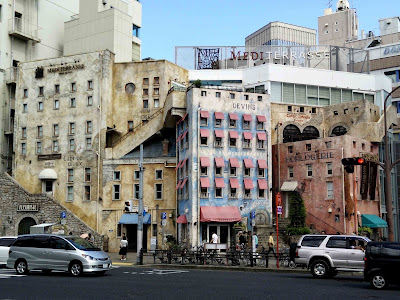After a successful move into my mountain-view apartment (see previous post), it was time to explore my new home and see what Kobe had to offer. Travelling down from Mount Rokko to get into the city was an
easy stroll, but boy was that a trek on the way back. I spent many late lights
(and a few early mornings) drudging myself up that mountainside, sweltering in
the thick, humid air. The way down to
Sannomiya however, as I said, was a doddle.
 Arriving in Sannomiya
(via any one of three parallel train
lines) you are immediately greeted by the usual tall buildings and clean
advertising of ‘big city’ Japan. Like
many of the metro lines throughout Japan, the space surrounding the train lines
is not left wasted and decrepit, but is vibrant, busy, and full of life. Shops,
restaurants, and bars litter the undercarriage of the tracks, with long
stretches of what one could call a ‘strip-mall’.
Arriving in Sannomiya
(via any one of three parallel train
lines) you are immediately greeted by the usual tall buildings and clean
advertising of ‘big city’ Japan. Like
many of the metro lines throughout Japan, the space surrounding the train lines
is not left wasted and decrepit, but is vibrant, busy, and full of life. Shops,
restaurants, and bars litter the undercarriage of the tracks, with long
stretches of what one could call a ‘strip-mall’.  One popular area in Sannomiya
is Ikuta road which houses a plethora
of bars, clubs, and variety of shops. Selling all sorts of wares, from shoes (I
bought some Dragon’s beard shoes made
in Osaka), to triangular watermelons, to Kobe
beef, you’d find whatever you’re looking for.
One popular area in Sannomiya
is Ikuta road which houses a plethora
of bars, clubs, and variety of shops. Selling all sorts of wares, from shoes (I
bought some Dragon’s beard shoes made
in Osaka), to triangular watermelons, to Kobe
beef, you’d find whatever you’re looking for. |
| Kobe Beef - it's everywhere! |
Moving away from Sannomiya
I wander to Chinatown, which was one
long street of Peking ducks, pork buns, and all the sweet and savoury dishes
you could imagine. I had a steamed pork bun (which was delicious), which I
later discovered was a snack that could be purchased hot and fresh in almost
any convenience store, anywhere in Japan. Oh well…
 |
| Chinatown |
Well I’ve rambled enough for today, soI hope you’ve enjoyed
these insights into Kobe and will
stay tuned for my visit to the UNESCO World Heritage site, Himeji Castle.







No comments:
Post a Comment